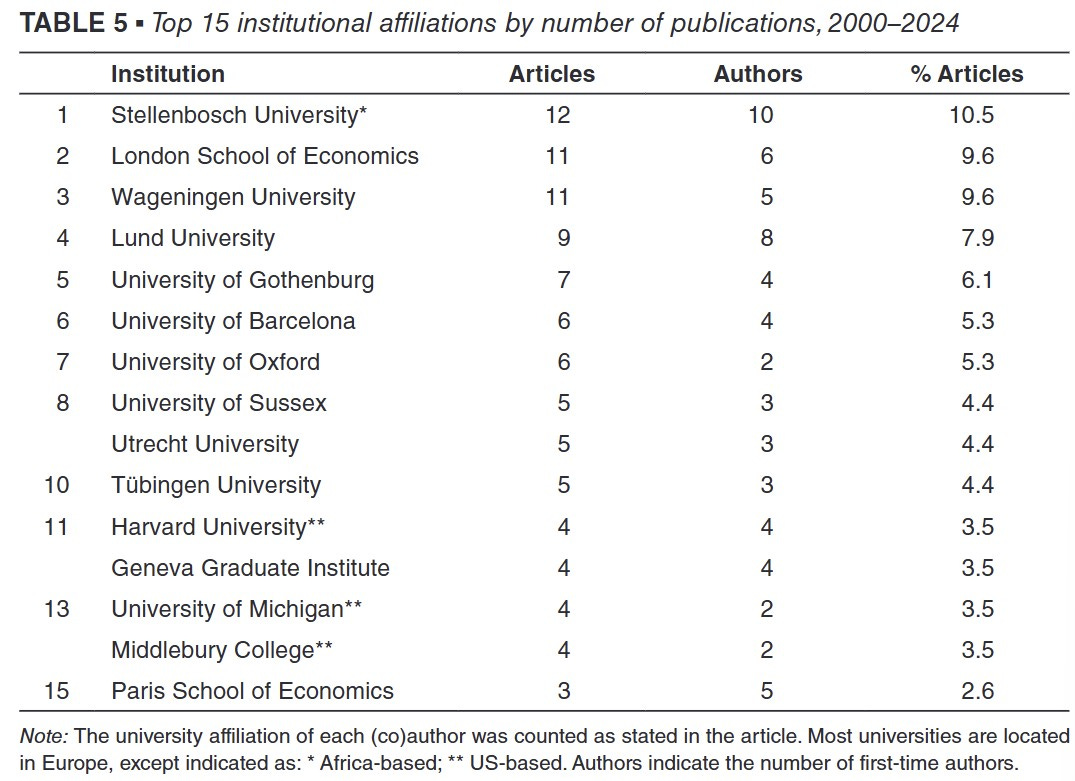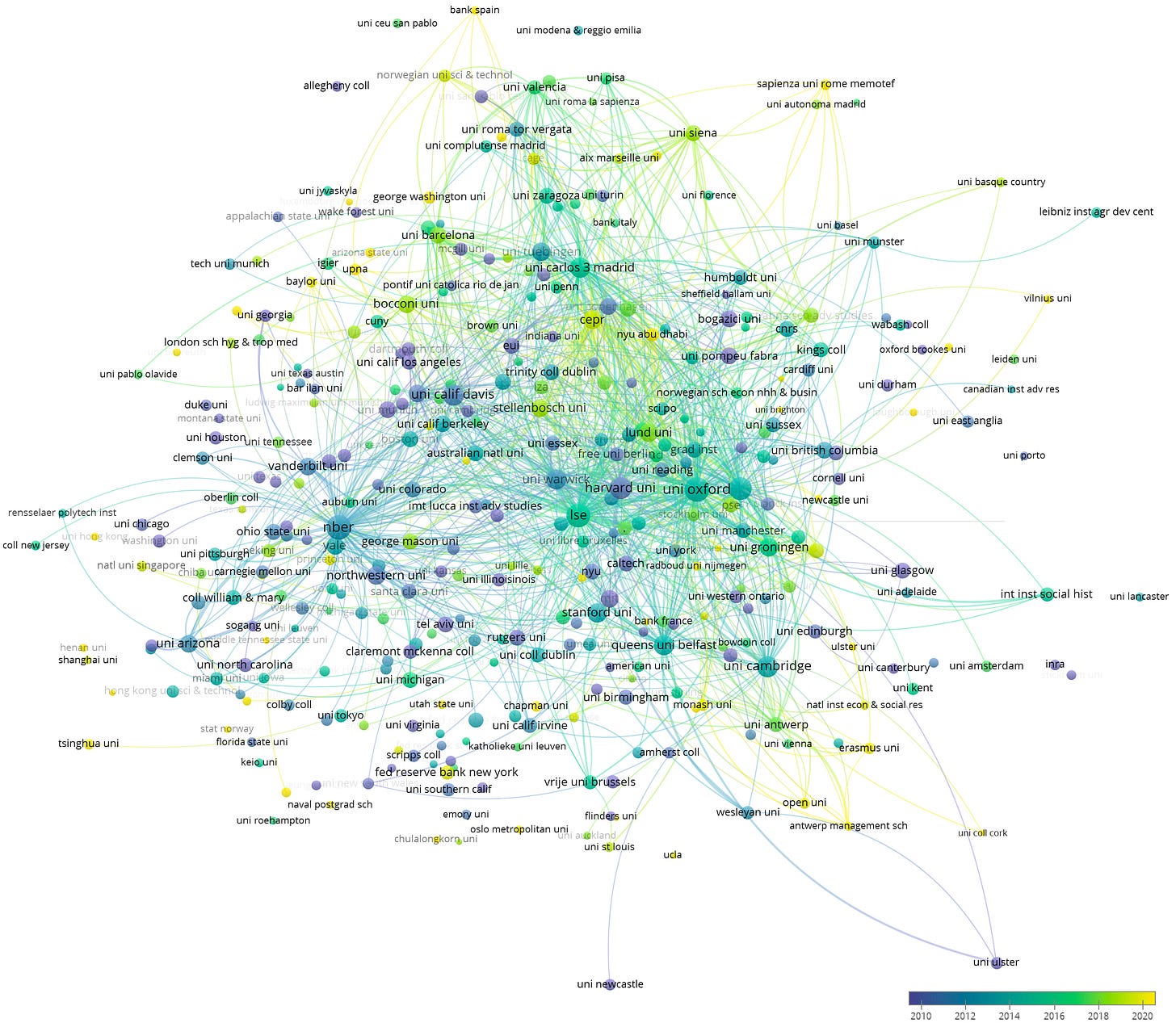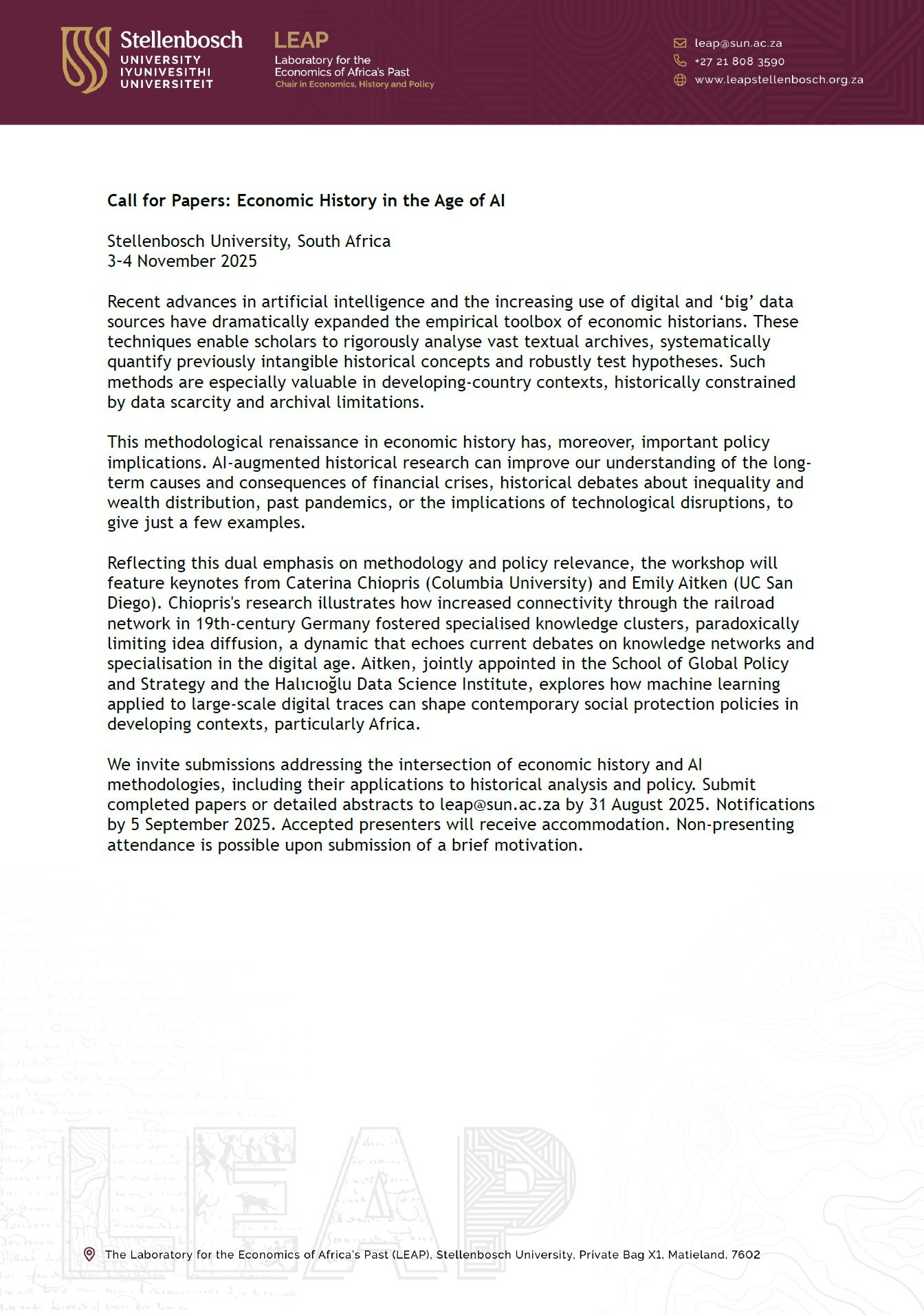Happy tenth birthday, LEAP!
Two new research papers show how economic history at Stellenbosch punches above its weight
When, in 2009, Stellenbosch University won the bid to host the World Economic History Congress, I suspect few, if any, of the world’s leading economic historians could locate Stellenbosch on a map. We had been asked to submit a bid and, thanks to an impassioned speech by Grietjie Verhoef in Japan, our bid was preferred to that of front-runner Sydney. (If you’ve been following this blog for a while, you’ll know why it gave me great satisfaction to beat the Aussies.) It was, to say the least, a vote of faith in a motley group of aspiring scholars who, for all our enthusiasm, had very little idea of what we were getting ourselves into.
Back then, we had hosted a few small economic history workshops, attracting one or two notable scholars willing to venture to the southern tip of Africa – including, as it turns out, now household names like James Robinson and Nathan Nunn. But we had published almost nothing in economic history; our first papers, in the European Review of Economic History and Cliometrica, would appear only in 2010.
Getting those first papers published, thanks to the encouragement of both our visitors and the journal editors, made a real difference. So did hosting regular ERSA Economic History workshops. And then, in what felt like the coldest Stellenbosch winter in living memory, came the 2012 World Economic History Congress.
Our research team was small: Sophia du Plessis, now departmental chair; Dieter von Fintel, now vice-dean research; and me – still a blogger. We also roped in a few of our colleagues from economics and history when necessary: Stan du Plessis, Estian Calitz, Ada Jansen, Krige Siebrits, and Anton Ehlers. But hosting the WEHC permitted our informal economic history research group to become, well, an informal economic history group with a name and a website: LEAP, the Laboratory for the Economics of Africa’s Past. We recruited our first PhD student in 2013, and she completed her PhD in 2016, a year after we launched LEAP, making it ten years old this year. More PhD students joined. Then postdocs. Then junior colleagues like Bokang Mpeta and Calumet Links.
In writing this, I decided to ask Jeanne Cilliers, our first PhD student and now a researcher in historical demography at Lund, why she chose to do a PhD with an economic history topic at Stellenbosch. She responded: Honest answer: because some crazy lecturer with grand ideas and questionable judgment convinced me it was a good idea. Quotable answer: because I still had unanswered research questions and the economics department at Stellenbosch stood out as the best place to find answers to them. For the record, I have excellent judgment.
We investigated a range of topics, from early Cape wealth and inequality to twentieth-century black living standards in South Africa. We benefited from collaborations with scholars at Lund, the LSE, Canberra, Barcelona, Guelph, Arizona, and the many, many places that have invited me and my colleagues and students to present our work. And, most recently, thanks to the incredible generosity of donors, notably Kris Inwood, who shipped his entire economic history library to us during the COVID-19 pandemic, and Keith Meintjes, a retired computer scientist, whose financial contribution allows us to provide bursaries to dozens of students every year.
What drew me to economic history, above all, was the extraordinary generosity of its scholars. From the beginning, colleagues like Gareth Austin, Jutta Bolt, Ewout Frankema, Leigh Gardner, Erik Green, Ellen Hillbom, Martine Mariotti, Alex Moradi, and Karin Pallaver have not only been leaders in the renaissance of the economic history of Africa but also generous supporters of our efforts in Stellenbosch. African economic history, much like cooperation in evolutionary biology, thrives under conditions of abundant resources and limited numbers. With vast unexplored territory and few scholars – much like the continent itself, characterised historically by high land-labour ratios – collaboration and collective effort consistently yield richer outcomes than direct competition ever could.
In 2023, LEAP was formalised as a Type 1 research centre, which means we now have a director (me) and a governing board. This formal status also requires us, increasingly, to quantify and therefore justify our impact. So it was rather nice to read two recent papers that do exactly that. The first, by Katharine Frederick, Dácil Juif and Felix Meier zu Selhausen, reviews the revival of African economic history over the last three decades. It was Table 5, in particular, that caught my attention: Stellenbosch scholars have published the highest number of papers on Africa in economic history journals over the last 25 years. While this will almost certainly change in the coming years – LEAP’s productivity has declined due to kids or promotions or both – it is still remarkable that our unit with zero outputs before 2010 has been able to achieve this.
What is also clear is that Stellenbosch is the only African university on that list. Frederick et al. also mention this:
… the ‘renaissance’ of AEH appears to not yet have crossed South Africa’s Limpopo River or Kalahari Desert. Research activity on the continent’s economic history has remained relatively confined to the dynamic centre of Stellenbosch and, in particular, its Laboratory for the Economics of Africa’s Past (LEAP), established within the Department of Economics in 2015.
Why this is so has been the topic of debate for more than a decade, and the answer(s) are not simple. With the rise of other centers of economic history, notably within the Economics department at the University of Pretoria, the host of the 2023 African Economic History Meetings, that might change soon.
The research we do at LEAP is not intended only for an African audience. For this reason, a second, more recent working paper by Gregori Galofré-Vilà and Víctor M. Gómez Blanco, which employs bibliometric analysis for all economic history papers, confirms the centrality of Stellenbosch in the global network. Examine the network graph below closely.1 Can you spot Stellenbosch? Search for the yellow dot at the centre of the network.
I quote from the paper:
… institutions from Asia, Africa, and Latin America are present but relatively peripheral. Only a few such institutions meet our inclusion threshold, and those that do appear tend not to form tight clusters but rather are individually connected to Western institutions.
Stellenbosch University stands out as an exception: it appears as a notable node (albeit smaller than the European/American hubs) and is positioned fairly centrally, likely serving as a bridge bringing African historical data and perspectives into the economic history journals.
Research success, like economic growth, is never guaranteed. It depends on a combination of creativity, persistence, timing, and, not infrequently, luck. Just as innovation flourishes in a supportive environment, we have benefited at Stellenbosch from an Economics department that has trusted its people, allowing ideas to grow and initiatives to take root with minimal interference. Such spaces, built on trust, are rare and worth cherishing. Perhaps there is a lesson in that for South Africa as well.
I hope we can continue to produce high-quality research that finds a wide audience. We’re still recruiting postdocs eager to apply new methods to African data, and thanks to the Chair, we now host at least two workshops every year. The next one is in November – the Call for Papers is below. You’re also welcome to join us in January for a workshop on slavery and emancipation, or for an ERSA workshop later that month. And Stellenbosch in summer is really not the worst place in the world. Come and see for yourself.
Back in 2009, Stellenbosch was just a guess on the map. Today, we’re a yellow dot at the centre of a bibliometric network, which in academia is about as good a birthday present as one can hope for.
‘Happy tenth birthday, LEAP!’ was first published on Our Long Walk. The images were created with Midjourney v6.
A big thank you to Gregori for redrawing the graph to make Stellenbosch more visible than the one in the paper!








Happy 10th Birthday Mant more and keep up the great work and the South African Flag Flying High.
Congratulations, Johan. It has been great to see LEAP grow from strength to strength.